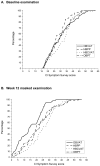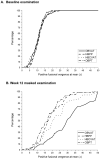Randomized clinical trial of treatments for symptomatic convergence insufficiency in children
- PMID: 18852411
- PMCID: PMC2779032
- DOI: 10.1001/archopht.126.10.1336
Randomized clinical trial of treatments for symptomatic convergence insufficiency in children
Abstract
Objective: To compare home-based pencil push-ups (HBPP), home-based computer vergence/accommodative therapy and pencil push-ups (HBCVAT+), office-based vergence/accommodative therapy with home reinforcement (OBVAT), and office-based placebo therapy with home reinforcement (OBPT) as treatments for symptomatic convergence insufficiency.
Methods: In a randomized clinical trial, 221 children aged 9 to 17 years with symptomatic convergence insufficiency were assigned to 1 of 4 treatments.
Main outcome measures: Convergence Insufficiency Symptom Survey score after 12 weeks of treatment. Secondary outcomes were near point of convergence and positive fusional vergence at near.
Results: After 12 weeks of treatment, the OBVAT group's mean Convergence Insufficiency Symptom Survey score (15.1) was statistically significantly lower than those of 21.3, 24.7, and 21.9 in the HBCVAT+, HBPP, and OBPT groups, respectively (P < .001). The OBVAT group also demonstrated a significantly improved near point of convergence and positive fusional vergence at near compared with the other groups (P <or= .005 for all comparisons). A successful or improved outcome was found in 73%, 43%, 33%, and 35% of patients in the OBVAT, HBPP, HBCVAT+, and OBPT groups, respectively.
Conclusions: Twelve weeks of OBVAT results in a significantly greater improvement in symptoms and clinical measures of near point of convergence and positive fusional vergence and a greater percentage of patients reaching the predetermined criteria of success compared with HBPP, HBCVAT+, and OBPT. Application to Clinical Practice Office-based vergence accommodative therapy is an effective treatment for children with symptomatic convergence insufficiency.
Trial registration: clinicaltrials.gov Identifier: NCT00338611.
Figures






Comment in
-
Treatment options for symptomatic convergence insufficiency.Arch Ophthalmol. 2008 Oct;126(10):1455-6. doi: 10.1001/archopht.126.10.1455. Arch Ophthalmol. 2008. PMID: 18852426 No abstract available.
References
-
- Letourneau JE, Lapierre N, Lamont A. The relationship between convergence insufficiency and school achievement. Am J Optom Physiol Opt. 1979;56:18–22. - PubMed
-
- Letourneau JE, Ducic S. Prevalence of convergence insufficiency among elementary school children. Can J Optom. 1988;50:194–197.
-
- Porcar E, Martinez-Palomera A. Prevalence of general binocular dysfunctions in a population of university students. Optom Vis Sci. 1997;74:111–113. - PubMed
-
- Rouse MW, Borsting E, Hyman L, et al. Frequency of convergence insufficiency among fifth and sixth graders. Optom Vis Sci. 1999;76:643–649. - PubMed
-
- Daum KM. Convergence insufficiency. Am J Optom Physiol Opt. 1984;61:16–22. - PubMed
Publication types
MeSH terms
Associated data
Grants and funding
LinkOut - more resources
Full Text Sources
Other Literature Sources
Medical

